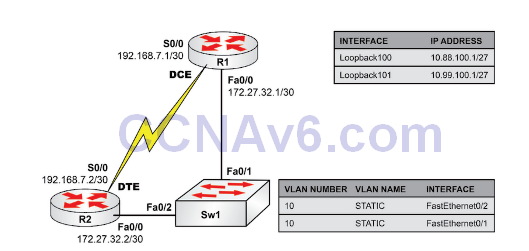Lab Objective:
The objective of this lab exercise is to configure named static routes via next hop IP addresses on interfaces connected to a switch on two routers. This lab also goes through the validation of the configured static routes.
Lab Purpose:
Static route configuration is a fundamental skill. There are several methods to configure static routes on a Cisco router, and each way has its pros and cons. Naming the static routes allows you to easily identify what each static route is used for as you view the router configuration. As a Cisco engineer, as well as in the Cisco CCNA exam, you will be expected to know how to configure named static routes via any of the methods available in Cisco IOS.
Certification Level:
This lab is suitable for both CCENT and CCNA certification exam preparation.
Lab Difficulty:
This lab has a difficulty rating of 5/10.
Readiness Assessment:
When you are ready for your certification exam, you should complete this lab in no more than 15 minutes.
Lab Topology:
Please use the following topology to complete this lab exercise:

Task 1:
Configure the hostnames on R1, R2, and Sw1 as illustrated in the topology.
Task 2:
Configure Sw2 as a VTP sever and configure VLAN10 named STATIC. Assign ports FastEthernet0/1 and FastEthernet0/2 to this VLAN. Configure the DCE interface Serial0/0 in R1 to provide clocking to R2 at a clock speed of 768 Kbps (not required if you are using GNS3).
Task 3:
Configure IP addresses 172.27.32.1/30 and 172.27.32.2/30 on R1 and R2 Fa0/0 interfaces, respectively. Configure IP addresses 192.168.7.1/30 and 192.168.7.2/30 on R1 and R2 S0/0 interfaces, respectively. In addition, configure the Loopback interfaces on R1 with the IP addresses in the topology.
Task 4:
Configure a static route named LAN-ROUTE on R2 via interface FastEthernet0/0 with a next hop IP address of 172.27.32.1 to the 10.88.100.1/27 subnet. Configure a static route named WAN-ROUTE on R2 via Serial0/0 with a next hop IP address of 192.168.7.1 to the 10.99.100.1/27 subnet. Verify your static route configuration.
Task 5:
Ping each Loopback interface configured on R1 from R2 to verify your static route configuration.
Configuration and Verification
Task 1:
For reference information on configuring hostnames, please refer to earlier labs.
Task 2:
For reference information on configuring standard VLANs, please refer to earlier labs.
Task 3:
For reference information on configuring IP interfaces, please refer to earlier labs.
Task 4:
R2(config)#ip route 10.88.100.0 255.255.255.224 fa0/0 172.27.32.1 name LAN-ROUTE
R2(config)#ip route 10.99.100.0 255.255.255.224 se0/0 192.168.7.1 name WAN-ROUTE
R2(config)#end
R2#
R2#show ip route
Codes: C - connected, S - static, R - RIP, M - mobile, B – BGP,
D - EIGRP, EX - EIGRP external, O - OSPF, IA - OSPF inter area,
N1 - OSPF NSSA external type 1, N2 - OSPF NSSA external type 2,
E1 - OSPF external type 1, E2 - OSPF external type 2,
i - IS-IS, su - IS-IS summary, L1 - IS-IS level-1,
L2 - IS-IS level-2, ia - IS-IS inter area,
* - candidate default, U - per-user static route, o - ODR,
P - periodic downloaded static route
Gateway of last resort is not set
172.27.0.0/24 is subnetted, 1 subnets
C 172.27.32.0 is directly connected, FastEthernet0/0
10.0.0.0/27 is subnetted, 2 subnets
S 10.88.100.0 [1/0] via 172.27.32.1, FastEthernet0/0
S 10.99.100.0 [1/0] via 192.168.7.1, Serial0/0
192.168.7.0/30 is subnetted, 1 subnets
C 192.168.7.0 is directly connected, Serial0/0
NOTE: The names configured on the static routes do not show in the output of the show ip route command; however, they do show in the running configuration. Naming static routes allows you to easily identify what the configured static routes are being used for. This can be extremely helpful in a router where you have many static routes configured. You can simply issue the show run command and filter the output to include only statements that contain the word route as illustrated below:
R2#show running-config | include route ip route 10.88.100.0 255.255.255.224 Ethernet0/0 172.27.32.1 name LAN-ROUTE ip route 10.99.100.0 255.255.255.224 Serial0/0 192.168.7.1 name WAN-ROUTE
Task 5:
For reference information on how to ping, refer to earlier labs.

“Task 2:Configure Sw2 as a VTP sever and configure VLAN10 named STATIC.”
There is no SW2, only SW1.